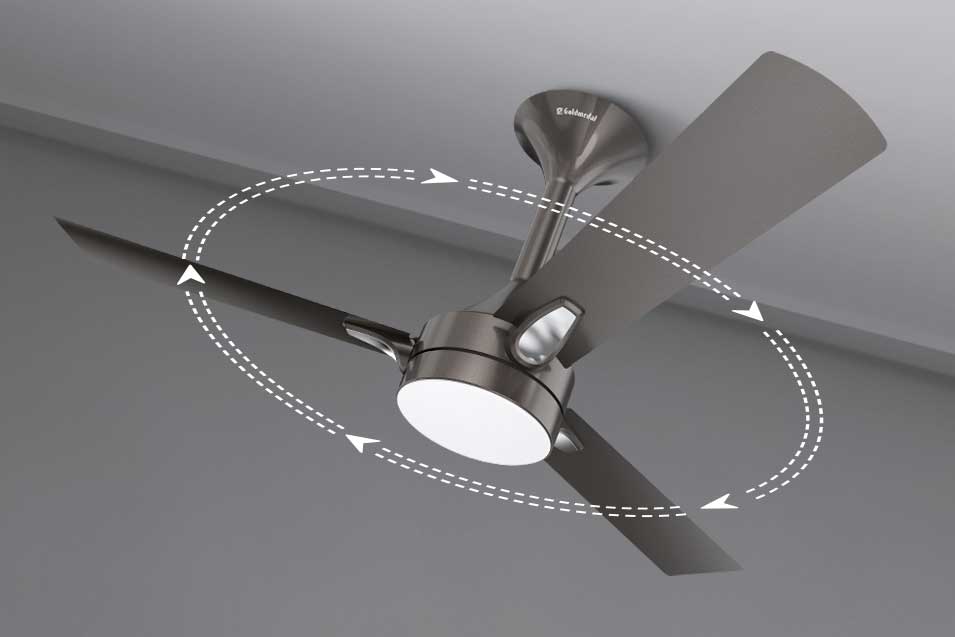
Why Does Ceiling Fan Rotate Anticlockwise?
It’s a warm lazy summer day, and you’re lying down on your bed, with your eyes on the ceiling, watching the fan go round in circles. Why does the ceiling fan rotate anticlockwise? What decides the ceiling fans’s rotation direction? Questions that pop up in your head.Relax. Chill in your bed and keep reading, while we unravel this mystery of why ceiling fans rotate anticlockwise.
The Ceiling Fan Mechanism
The direction of the fan is influenced by the ceiling fan design. The mechanism of a fan includes two important parts called the stator and the rotor. Either the stator or the rotor can be moving, while the other remains stationary. What decides the direction of the fan depends on whether the stator or the rotor is the moving part. In the case of a ceiling fan, the armature winding is on the rotor shaft, which causes the stator to rotate. This is driven by a scientific principle called the Left Hand Thumb rule, which causes a clockwise flow of current in the armature on the rotor, and causes the stator to rotate anticlockwise. The fan blades of a ceiling fan are mounted on the stator. Hence we see the blades moving anticlockwise.
Design of the Blades
The direction of the ceiling fan is decided by the design of the blades and follows the universal standards for ceiling fan design. Technically, it does not matter which direction a fan rotates in, as long as the fan blades are designed to push the air in the desired direction. The idea is to create a downward draft of air to help cool the room.
The ceiling fan has historically evolved to its current state, and it makes sense from a mass manufacturing point of view, to stick to a universal standard for the ceiling fan rotation direction.
Ceiling Fans Rotating Anticlockwise
Now that we’ve seen why ceiling fans rotate anticlockwise, let’s look at what is the result of this motion. Most modern ceiling fans today move in the anticlockwise direction when viewed from below. The blades of the ceiling fan are designed to create a downward draft of air that circulates the air and cools the room. The ceiling fan does not reduce the temperature of the room but rather helps to control the air circulation. This helps in warmer climates by effectively evaporating human sweat and providing a cooling effect.
Can Ceiling Fans Rotate Clockwise?
Yes, ceiling fans can be made to rotate clockwise as well. We’ve seen that the anticlockwise motion causes the ceiling fan to provide a cooling effect. In the reverse manner, the same fan can provide an opposite effect in the winter months. In colder climates, warm air accumulates in the upper part of the room. When the ceiling fan rotates clockwise, the fan blades push the warm air from above, reducing the cold by a small degree.
Not all ceiling fans are equipped to rotate clockwise. Some ceiling fans come equipped with a switch in the fan which can be flipped to change the direction of rotation. Some remote ceiling fans can change this setting remotely, without the need to have to do this manually by a technician. This can be beneficial in places that experience extreme weather at different times of the day and night.
In Conclusion
We’ve addressed the question of why does the ceiling fan rotate anticlockwise. We’ve seen that two important factors that decide the ceiling fan’s rotation direction are the ceiling fan design and the design of the blades. We know now that the global norms have been adapted by ceiling fan manufacturers over the years to have better compatibility and convenience, especially during parts replacement.
So yes, round and round goes the ceiling fan, anticlockwise. While you look at it going in circles on a warm lazy summer day.
Frequently Asked Questions (FAQs) :
Q1. Can I Leave My Ceiling Fan On All Night?
Absolutely! Ceiling fans are designed for continuous operation and consume minimal energy compared to air conditioning units. However, ensure the fan is set to an appropriate speed for comfort and energy efficiency.
Q2. Do Ceiling Fans Cool the Room?
While ceiling fans don’t lower the room temperature like air conditioners, they create a perceived cooling effect by circulating air and facilitating evaporative cooling.
Q3. Why does my ceiling fan wobble?
Ceiling fan wobbling can be caused by various factors, including improper installation, unbalanced blades, or a faulty motor. Ensuring proper installation and regular maintenance can help alleviate this issue.
Q4. How do I know if my ceiling fan is set to rotate in the correct direction?
Stand directly beneath the fan and observe the direction of the airflow. In summer mode, you should feel a breeze blowing downwards, while in winter mode, you may not feel any airflow or feel a gentle updraft.
Q5. Can I install a ceiling fan myself?
While it is possible to install a ceiling fan yourself, it’s essential to follow the manufacturer’s instructions carefully and ensure proper electrical wiring and mounting. If you’re unsure, it’s best to consult a professional electrician for installation.

